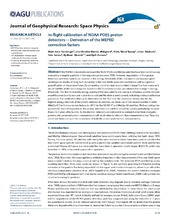| dc.contributor.author | Sandanger, Marit Irene | |
| dc.contributor.author | Ødegaard, Linn-Kristine Glesnes | |
| dc.contributor.author | Tyssøy, Hilde Nesse | |
| dc.contributor.author | Stadsnes, Johan | |
| dc.contributor.author | Søraas, Finn | |
| dc.contributor.author | Oksavik, Kjellmar | |
| dc.contributor.author | Aarsnes, Kjell | |
| dc.date.accessioned | 2016-04-05T15:33:02Z | |
| dc.date.available | 2016-04-05T15:33:02Z | |
| dc.date.issued | 2015-11-25 | |
| dc.Published | Journal of Geophysical Research - Space Physics 2015, 120(11):9578-9593 | eng |
| dc.identifier.issn | 2169-9402 | en_US |
| dc.identifier.uri | https://hdl.handle.net/1956/11858 | |
| dc.description.abstract | The MEPED instruments on board the NOAA POES and MetOp satellites have been continuously measuring energetic particles in the magnetosphere since 1978. However, degradation of the proton detectors over time leads to an increase in the energy thresholds of the instrument and imposes great challenges to studies of long-term variability in the near-Earth space environment as well as a general quantification of the proton fluxes. By comparing monthly mean accumulated integral flux from a new and an old satellite at the same magnetic local time (MLT) and time period, we estimate the change in energy thresholds. The first 12 monthly energy spectra of the new satellite are used as a reference, and the derived monthly correction factors over a year for an old satellite show a small spread, indicating a robust calibration procedure. The method enables us to determine for the first time the correction factors also for the highest-energy channels of the proton detector. In addition, we make use of the newest satellite in orbit (MetOp-01) to find correction factors for 2013 for the NOAA 17 and MetOp-02 satellites. Without taking into account the level of degradation, the proton data from one satellite cannot be used quantitatively for more than 2 to 3 years after launch. As the electron detectors are vulnerable to contamination from energetic protons, the corrected proton measurements will be of value for electron flux measurements too. Thus, the correction factors ensure the correctness of both the proton and electron measurements. | en_US |
| dc.language.iso | eng | eng |
| dc.publisher | Wiley | en_US |
| dc.relation.ispartof | <a href="http://hdl.handle.net/1956/16244" target="_blank">Energetic particle precipitation into the middle atmosphere - optimization and applications of the NOAA POES MEPED data</a> | en_US |
| dc.rights | Attribution CC BY-NC-ND | eng |
| dc.rights.uri | http://creativecommons.org/licenses/by-nc-nd/3.0/ | eng |
| dc.title | In-flight calibration of NOAA POES proton detectors - Derivation of the MEPED correction factors | en_US |
| dc.type | Peer reviewed | |
| dc.type | Journal article | |
| dc.date.updated | 2016-01-12T13:45:13Z | |
| dc.description.version | publishedVersion | en_US |
| dc.rights.holder | Copyright 2015 the authors | en_US |
| dc.identifier.doi | https://doi.org/10.1002/2015ja021388 | |
| dc.identifier.cristin | 1311188 | |

